
Carbonic maceration is a winemaking technique, often associated with the French wine region of Beaujolais, in which whole grapes are fermented in a carbon dioxide rich environment prior to crushing. Conventional alcoholic fermentation involves crushing the grapes to free the juice and pulp from the skin with yeast serving to convert sugar into ethanol. Carbonic maceration ferments most of the juice while it is still inside the grape, although grapes at the bottom of the vessel are crushed by gravity and undergo conventional fermentation. The resulting wine is fruity with very low tannins. It is ready to drink quickly but lacks the structure for long-term aging. In the most extreme case, such as with Beaujolais nouveau, the period between picking and bottling can be less than six weeks.
Aubun is a red wine grape grown primarily in the Rhône valley. The grape has similar characteristics to Carignan grapes in that it tends to produce high yields and produces wines that are fat with slight bitter finishes. Early during the phylloxera epidemic of the 19th century, the Auban vines showed some resistance to the pest as well as to downy and powdery mildew. The vines tends to bud late and not be affected by spring frost. In 2000, there were 1,400 hectares of Aubun in France.

Aramon or Aramon noir is a variety of red wine grape grown primarily in Languedoc-Roussillon in southern France. Between the late 19th century and the 1960s, it was France's most grown grape variety, but plantings of Aramon have been in continuous decline since the mid-20th century. Aramon has also been grown in Algeria, Argentina and Chile but nowhere else did it ever reach the popularity it used to have in the south of France.

Marzemino is a red Italian wine grape variety that is primarily grown around Isera, south of Trentino. The wine is most noted for its mention in the opera Don Giovanni of Wolfgang Amadeus Mozart. The vine ripens late and is susceptible to many grape diseases including oidium. Wine produced from the grape has a characteristic dark tint and light plummy taste.
Molinara is a red Italian wine grape which accounted for 595 hectares of planting land in Italy as of 2010, almost exclusively in the Veneto region. It adds acidity to the wines of the Valpolicella and Bardolino regions, which are made with blends of Corvina, Corvinone, Molinara and Rondinella. The wine's high propensity for oxidation, coupled with its low color extract, has caused a decline in favor and plantings among Venetian vineyards, declining in ten years by more than half from an area of 1,301 hectares in 2000. There has been debate about whether the grape is purple or blue. This grape is occasionally blended with Merlot to produce soft elegant rosés, and Molinara also accounts for 122 hectares of planting land in Spain.
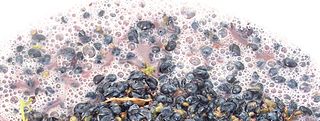
The process of fermentation in winemaking turns grape juice into an alcoholic beverage. During fermentation, yeasts transform sugars present in the juice into ethanol and carbon dioxide. In winemaking, the temperature and speed of fermentation are important considerations as well as the levels of oxygen present in the must at the start of the fermentation. The risk of stuck fermentation and the development of several wine faults can also occur during this stage, which can last anywhere from 5 to 14 days for primary fermentation and potentially another 5 to 10 days for a secondary fermentation. Fermentation may be done in stainless steel tanks, which is common with many white wines like Riesling, in an open wooden vat, inside a wine barrel and inside the wine bottle itself as in the production of many sparkling wines.

Vietnamese wine is wine produced in Vietnam. The area was first cultivated for viticulture during the French colonial rule of the region in the late 19th century. The region's tropical climate was ill-suited for the type of Vitis vinifera that the French colonists were used to and the wine industry turned its attention to fruit wine production. The late 20th century saw renewed focus on the development of Vitis vinifera with the assistance of flying winemakers from regions like Australia. In 1995, a joint venture with Australian winemakers started an aggressive planting scheme to reintroduce international grape varieties like Cabernet Sauvignon and Chardonnay to land that was until recently littered with landmines left over from the Vietnam War.
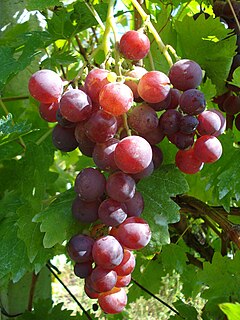
Cardinal is a table grape variety first produced in California in 1939.
Côtes du Marmandais is an Appellation d'origine contrôlée (AOC) for wine located in South West France around the commune of Marmande. With its location just southeast of the Entre-Deux-Mers along the banks of the Garonne river, it is a satellite of Bordeaux, but just outside the borders of that region. The region was elevated from Vin Délimité de Qualité Superieure (VDQS) to AOC status in 1990. From the Middle Ages to the 19th century, the wines of the Côtes du Marmandais were widely exported to the Netherlands. The Phylloxera epidemic wiped out most of the vineyards in this area with many farmers switching to other agricultural crops. It was not until the later half of the 20th century that viticulture in the area reaffirmed itself.
Manseng noir is a wine grape variety of Basque origins that is grown primarily in South West France. It is allowed into Béarn AOC wine but very little used. Manseng Noir is deep in colour and tannic.

Petit Manseng is a white wine grape variety that is grown primarily in South West France. It produces the highest quality wine of any grape in the Manseng family. The name is derived from its small, thick skin berries. Coupled with the small yields of the grapevine, most Petit Manseng farmers produce around 15 hl of wine per hectare. The grape is often left on the vine till December to produce a late harvest dessert wine. The grape is grown primarily in Gascony, Jurançon and Pacherenc du Vic-Bilh but has recently drawn interest in New World wine regions like California, North Georgia, Virginia, Ohio, and Australia. The reason is that it is expected to follow Viognier's path to popularity among white wine drinkers. It was already present in Uruguay, when Basque settlers brought "Manseng" and Tannat vines with them to their new home. Despite being easily recognizable as a white grape while true Manseng is a black grape, wine that is Petit Manseng is still normally labeled as just "Manseng". The grape is often left on the vine to produce a late harvest wine made from its nearly raisin like grapes.

Cru is "a vineyard or group of vineyards, especially one of recognized quality". It is a French wine term which is traditionally translated as "growth", as it was originally the past participle of the verb "croître". As a wine term it is closely connected to terroir in the sense of an "extent of terrain having a certain physical homogeneity. .. considered from the point of view of the nature of the soil as communicating a particular character to its produce, notably to wine". It may thus be defined as: "Terroir as a place of production" or an "Ensemble of terrains considered from the point of view of what grows there, from a particular cultivation." More specifically, cru is often used to indicate a specifically named and legally defined vineyard or ensemble of vineyards and the vines "which grow on [such] a reputed terroir; by extension of good quality." The term is also used to refer to the wine produced from such vines. The term cru is often used within classifications of French wine. By implication, a wine that displays the name of its cru on its wine label is supposed to exhibit the typical characteristics of this cru. The terms Premier Cru, Grand Cru, etc., are generally translated into English as First Growth, Great Growth, etc.; they designate levels of presumed quality that are variously defined in different wine regions.
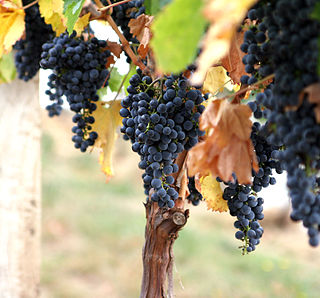
The annual growth cycle of grapevines is the process that takes place in the vineyard each year, beginning with bud break in the spring and culminating in leaf fall in autumn followed by winter dormancy. From a winemaking perspective, each step in the process plays a vital role in the development of grapes with ideal characteristics for making wine. Viticulturalists and vineyard managers monitor the effect of climate, vine disease and pests in facilitating or impeding the vines progression from bud break, flowering, fruit set, veraison, harvesting, leaf fall and dormancy-reacting if need be with the use of viticultural practices like canopy management, irrigation, vine training and the use of agrochemicals. The stages of the annual growth cycle usually become observable within the first year of a vine's life. The amount of time spent at each stage of the growth cycle depends on a number of factors-most notably the type of climate and the characteristics of the grape variety.

In viticulture, the canopy of a grapevine includes the parts of the vine visible aboveground - the trunk, cordon, stems, leaves, flowers, and fruit. The canopy plays a key role in light energy capture via photosynthesis, water use as regulated by transpiration, and microclimate of ripening grapes. Canopy management is an important aspect of viticulture due to its effect on grape yields, quality, vigor, and the prevention of grape diseases. Various viticulture problems, such as uneven grape ripening, sunburn, and frost damage, can be addressed by skillful canopy management. In addition to pruning and leaf trim, the canopy is often trained on trellis systems to guide its growth and assist in access for ongoing management and harvest.

Sugars in wine are at the heart of what makes winemaking possible. During the process of fermentation, sugars from wine grapes are broken down and converted by yeast into alcohol (ethanol) and carbon dioxide. Grapes accumulate sugars as they grow on the grapevine through the translocation of sucrose molecules that are produced by photosynthesis from the leaves. During ripening the sucrose molecules are hydrolyzed (separated) by the enzyme invertase into glucose and fructose. By the time of harvest, between 15 and 25% of the grape will be composed of simple sugars. Both glucose and fructose are six-carbon sugars but three-, four-, five- and seven-carbon sugars are also present in the grape. Not all sugars are fermentable with sugars like the five-carbon arabinose, rhamnose and xylose still being present in the wine after fermentation. Very high sugar content will effectively kill the yeast once a certain (high) alcohol content is reached. For these reasons, no wine is ever fermented completely "dry". Sugar's role in dictating the final alcohol content of the wine sometimes encourages winemakers to add sugar during winemaking in a process known as chaptalization solely in order to boost the alcohol content – chaptalization does not increase the sweetness of a wine.
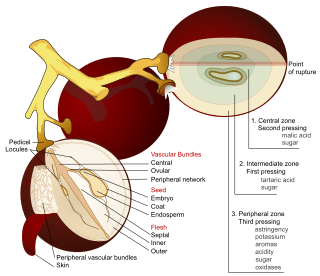
The acids in wine are an important component in both winemaking and the finished product of wine. They are present in both grapes and wine, having direct influences on the color, balance and taste of the wine as well as the growth and vitality of yeast during fermentation and protecting the wine from bacteria. The measure of the amount of acidity in wine is known as the “titratable acidity” or “total acidity”, which refers to the test that yields the total of all acids present, while strength of acidity is measured according to pH, with most wines having a pH between 2.9 and 3.9. Generally, the lower the pH, the higher the acidity in the wine. However, there is no direct connection between total acidity and pH. In wine tasting, the term “acidity” refers to the fresh, tart and sour attributes of the wine which are evaluated in relation to how well the acidity balances out the sweetness and bitter components of the wine such as tannins. Three primary acids are found in wine grapes: tartaric, malic and citric acids. During the course of winemaking and in the finished wines, acetic, butyric, lactic and succinic acids can play significant roles. Most of the acids involved with wine are fixed acids with the notable exception of acetic acid, mostly found in vinegar, which is volatile and can contribute to the wine fault known as volatile acidity. Sometimes, additional acids, such as ascorbic, sorbic and sulfurous acids, are used in winemaking.
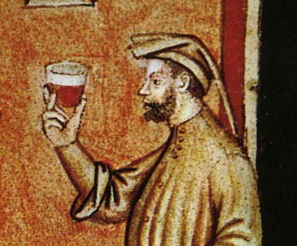
Old World wine refers primarily to wine made in Europe but can also include other regions of the Mediterranean basin with long histories of winemaking such as North Africa and the Near East. The phrase is often used in contrast to "New World wine" which refers primarily to wines from New World wine regions such as the United States, Australia, South America and South Africa. The term "Old World wine" does not refer to a homogeneous style with "Old World wine regions" like Austria, France, Italy, Portugal, and Spain each making vastly different styles of wine even within their own borders. Rather, the term is used to describe general differences in viticulture and winemaking philosophies between the Old World regions where tradition and the role of terroir lead versus the New World where science and the role of the winemaker are more often emphasized. In recent times, the globalization of wine and advent of flying winemakers have lessened the distinction between the two terms with winemakers in one region being able to produce wines that can display the traits of the other region—i.e. an "Old World style" wine being produced in a New World wine region like California or Chile and vice versa.
Ségalin is a red French wine grape variety that is a crossing of Jurançon noir and Portugais. As a varietal, Ségalin has the potential to produce well structured wines.

The aromas of wine are more diverse than its flavors. The human tongue is limited to the primary tastes perceived by taste receptors on the tongue-sourness, bitterness, saltiness, sweetness and savoriness. The wide array of fruit, earthy, leathery, floral, herbal, mineral, and woodsy flavor present in wine are derived from aroma notes sensed by the olfactory bulb. In wine tasting, wine is sometimes smelled before being drunk in order to identify some components of the wine that may be present. Different terms are used to describe what is being smelled. The most basic term is aroma which generally refers to a "pleasant" smell as opposed to odor which refers to an unpleasant smell or possible wine fault. The term aroma may be further distinguished from bouquet which generally refers to the smells that arise from the chemical reactions of fermentation and aging of the wine.
Asprinio bianco is a white Italian wine grape variety grown primarily in southwest Italy around the Naples region of Campania. It is currently not believed to be related to the similarly named French wine grape of the Languedoc region, Aspiran. In Naples the grape is used to make lightly sparkling frizzante wine.


















